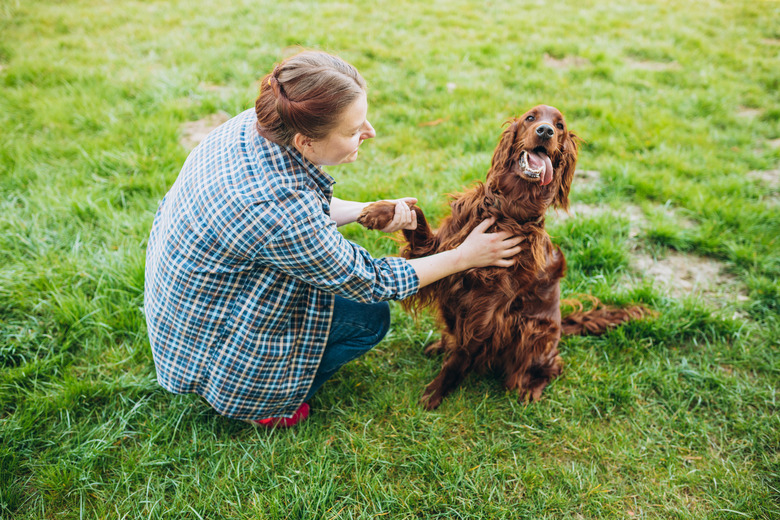What Is Learned Helplessness In Dogs?
Dogs are highly resilient beings. But when they are mistreated, they can develop a condition known as learned helplessness. This occurs after having been repeatedly exposed to frightening, overwhelming, or painful experiences. A dog can become so shut down that they are unable to react to those stressful situations in the future. With learned helplessness, dogs may not even be able to do simple things to alleviate the pain inflicted on them.
What are learned helplessness and classical conditioning?
What are learned
helplessness and classical conditioning?
The American Psychological Association explains that the idea of learned helplessness comes from studies done by Dr. Martin Seligman in the 1960s. In his classical conditioning study, the dogs would make the association between a ringing bell and the shocking aversive stimuli they were receiving.
Classical conditioning is a learning theory term that references learning through association. With classical conditioning, something that previously had no meaning to a dog becomes associated with something. For example, the sound of keys being picked up doesn't have any inherent value or meaning to dogs. However, many dogs are classically conditioned to associate the sound of those keys with something highly rewarding — like going for a walk. In the future, anytime a dog hears keys jingling they assume a walk is going to happen.
Classical conditioning is sometimes utilized in training. An example of this is clicker training. During the training, dogs learn to associate the clicker sound with a reward. Though it can also be used to cue dogs that something painful is going to happen — as was the case in Seligman's study. As part of his research, Seligman discovered that the dogs would begin to respond as though they had been shocked when they heard the bell ringing. But the dogs responded before the shock even happened to them — they had been classically conditioned to associate the ringing of the bell with pain.
The studies found that some dogs were able to move away to end the shocks. However, the dogs who had been shocked uncontrollably in the earlier experiments didn't attempt to get away during these later studies. These dogs expressed symptoms of anxiety and depression but wouldn't move, they had learned helplessness. Although this study was looking at dog behavior, learned helplessness can occur with any animal, not just dogs.
How does learned helplessness happen to dogs?
How does learned
helplessness happen to dogs?
Learned helplessness in dogs doesn't just happen in laboratory environments. It can occur to companion dogs in the real world to dogs who have been mistreated either through improper management or through aversive training methodologies. These dogs who have learned helplessness will shut down in the face of future stressors in their environment, not just direct corrections. In these instances, learned helplessness looks like dogs who have given up on their own well-being, interests, instincts, and desires.
Signs of learned helplessness in dogs
Signs of learned
helplessness in dogs
Dogs who have been abused, controlled, and trained using painful and aversive methodologies as part of dog training can become shut down. They can appear to have almost given up on life. Dogs who are experiencing learned helplessness may seem lethargic, passive, and as though they have given up on engaging. These dogs are likely to express a variety of stress signals such as excessive panting, ears pinned, lip licking, and shaking.
Dogs that experience learned helplessness can recover through proper training and interactions, but it takes time. Their ability to make choices and act like a dog can take time to be regained. Dogs that have developed learned helplessness are in a near-constant state of stress and fear. They don't want to play or interact. Recovering from learned helplessness can take them months or even years to overcome.
A quiet dog isn't always a calm dog
A quiet dog isn't always a calm dog
Unfortunately, sometimes dog owners and inexperienced trainers will make the inaccurate assumption that a dog who is quiet is calm. Just because a dog isn't being loud and reactive barking or lunging doesn't mean a dog is happy or comfortable.
Dogs that are trained using aversive techniques like shock/e-collars and prong collars are likely to develop symptoms of learned helplessness. If you look at a dog's body language, you'll be able to determine if they are calm and relaxed, or if they are quiet but also expressing symptoms of stress.
If you see a trainer using aversive tools and techniques and claiming the dog, they are working with is "cured" or "better" because the dog is laying silently in a stay, be aware the dog's behavior hasn't been solved, the dog is shut down, and expressing symptoms of learned helplessness.
The most important thing that dog owners can do to help prevent their dogs from ever experiencing the devastating effects of learned helplessness is to give their dogs the opportunity to be dogs. Only use positive reinforcement training techniques when working with your dog.
In summary
In summary
Turning a dog's life around to overcome learned helplessness takes time. Sometimes, it can take months or even years to rebuild their confidence. With time, they can learn new reactions and coping skills. You should always use positive reinforcement techniques when teaching a dog a new skill. Never use aversive tools or techniques. Aversives are intended to shut down a dog and suppress their natural instincts. If you have a dog who has been mistreated in the past and you suspect they are suffering from learned helplessness, work with a qualified dog trainer. Find a trainer that utilizes positive reinforcement training techniques. Dogs should always be treated gently and kindly during their training.



